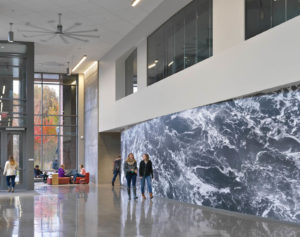
If you follow interior design news, you probably know that major paint companies Benjamin Moore and Sherwin-Williams herald Simply White and Alabaster as their respective 2016 “colors of the year.” Fortunately for those who eschew plain vanilla environments, there’s another growing trend: walls and even windows brought to life with digitally printed graphics.
In a 2015 study commissioned from Interior Design magazine by HP Inc., 61 percent of surveyed interior designers, architects and facilities managers said they were specifying more digitally printed wallcoverings than in the previous two years.
“Digital printing opens many opportunities from a design standpoint, as there are no longer any restrictions on scale or the number of colors,” says Asaf Lavi, U.S. décor business segment manager at HP Inc. in Alpharetta, Ga. “Digital printing pushes design boundaries and fosters creativity, reinventing interior décor possibilities. Historically, the design industry has only considered analog printing technology for design projects (using patterns, for example). But in the last few years, surface designers have discovered and embraced the limitless possibilities of digital printing. They are requesting more unique designs than they would have considered in the past.
“We see hospitality, corporate offices and retail as fast-growing markets for digital wallcovering,” Lavi adds. “But with the growing trend of e-commerce, cool designs, new solutions such as HP WallArt [Suite], and easy-to-install materials, we anticipate fast growth among consumers, too.”
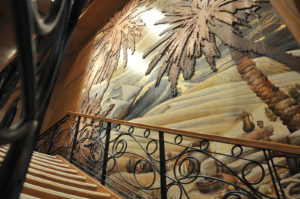
D.I.Y. (Design It Yourself)
“I believe designers and specifiers are increasingly aware that they can customize any part of their interior projects,” says Roy Ritchie Jr., president of wallcovering for Roysons Corp., Rockaway, N.J. “Digital printing is used on a wide range of interior décor—and for good reason. Clients want to distinguish their properties and have complete control over all aspects of the interiors. Each year the technology advances, creating better quality, reducing lead time and making the entire process more affordable. Not too long ago, we saw this level of customization reserved for high-budget properties. Now we see it expanding to a wider audience.”
“There’s no question, it’s huge,” says Timothy Mitchell, latex specialist at HP. “We have done a lot of research on it. Signage and display is a very well-cultivated market. Now we are very strong in wallcoverings of all varieties, as well as canvases and window treatments. We are all in on digital. We developed a whole wallcovering suite of software free with any HP latex printer so that people can do their own interior design.”
Marissa Howe, marketing coordinator for OAI Inc. of Tampa, Fla., credits programs like the HP WallArt Suite and other customer-friendly software for the increase in digitally printed interior décor.
“They allow designers to create and replicate their room design and upload art files to see those designs as a proof,” she says.
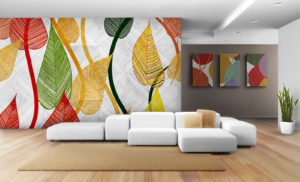
Rainier Industries Ltd. of Tukwila, Wash., provides wall and window coverings, murals and dimensional décor, the latter typically for in-store spaces and events. Retail décor is the largest segment of Rainier’s client base for those products, closely followed by the hospitality and medical industries. End users account for 90 percent of sales; designers and other specifiers make up the other 10 percent.
“Businesses today want to make their environments unique,” sales manager Charlie Rueb says. “We have been working in décor for over 10 years and have seen steady growth in the market. It seems more and more commercial printers are offering décor solutions as part of their portfolio.”
To market, to market
Cleveland, Ohio-based 4walls grew out of a company serving the residential market with borders, peel-and-stick wall accents and small murals. But creative director Greg Koeberer says, “that market dropped off in the late ’90s, so we turned our attention to commercial settings.”
Since 1998, 4walls has sold wallcoverings and large-scale murals almost exclusively through distribution
to design professionals, especially for use in reception areas, patient rooms, meeting spaces and corridors in health care and hospitality settings. Other installations include corporate offices and, to a smaller degree, restaurants and retail spaces.
“We have come back around to residential—about 20 percent of our business, especially in high-end homes—and are back to investigating ways we can adapt our designs and techniques for that market,” Koeberer says, noting that designs for commercial settings may be scaled too large for homes, and that the “high-pop colors that excite the commercial market” may be too bold for the more neutral color palettes in homes.
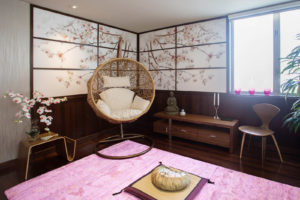
“Sometime this year, we will delve back into the residential market in more detail, but we’re not focusing on commodity items like peel and stick,” Koeberer says. “We’ll focus on large walls and murals for great rooms.”
Roysons’ DreamScape™ division “has something for everyone,” Ritchie says. “We find success in commercial and residential projects. Our client base ranges from large print service providers to traditional wallcovering manufacturers who utilize digital print technology. Our focus has always been wall graphics, but we are looking at flooring and windows.”
The bulk of DreamScape sales are Type II flame-rated materials in high-volume projects for retail chains, hotel properties, casinos, restaurants and office buildings.
“We have 21 items that are fabric-backed vinyls and feature a large range of textures. We have three that are nonwoven, two of which feature embossing, and four that are polyester based,” Ritchie says. “DreamGuard™ is a water-based coating that can be machine applied or hand applied after the wallcoverings are printed.”
Rainier primarily uses Type II vinyl for wallcoverings and polyester for window coverings, but also uses plastic, paper and wood for digital décor. The company uses water-based, UV-curable and water-based dye sublimation inks and offers a water-based UV coating.
“The size of the finished piece is determined by the customer’s imagination,” Rueb says. “We haven’t been asked to do something larger than we can. For example, we did a fabric wall for the University of Virginia that was 16 feet tall by 300 feet long.”
4walls’ most-often specified material—about 80 percent of the time, Koeberer says—is Type II 20-ounce vinyl. The company also offers a PVC-free wallcovering as well as woven fabrics. Window films are printed on polyester, but also can be produced on polycarbonate. Though seldom specified, recycled vinyl, burlap, silk, jute and paper weave are also available. 4walls mostly uses UV-curable inks, but often uses latex inks for a variety of substrates. Frequently, a liquid laminate topcoat is added for performance features such as durability.
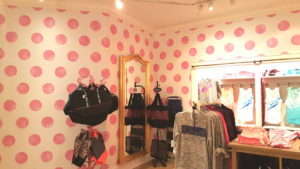
Going up?
Koeberer thinks the increase in digital interior décor is driven by people’s exposure to it. “We have seen a huge uptick in window films on glass partitions because there are so many open spaces in offices and it gives workers more privacy,” he says.
David Siegel, director of surface imaging for Designtex, says there are multiple drivers behind the wheel on the digital printing highway: “the ability to design completely custom materials specific to a client’s brand or design intent, the reduced cost to do so, the increased performance of materials, and the awareness among interior designers about how to use them to accomplish their projects.”
Architecture and design firms specify Designtex wall and window coverings, upholstery, panels and curtains for their corporate, health care, hospitality and institutional clients. The vast majority of the New York City, N.Y.-based company’s digitally printed textiles are polyester. Its chief technologies are UV-curable and dye sublimation inks.
HP’s Mitchell is optimistic about the results of a chemistry-related endeavor with Green Textile of Spartanburg, S.C.
“Up to now, people have printed on whatever was in the market. That is changing,” he says. “Green Textile has developed a coated polyester fabric that is highly latex specific. What we always wanted was better scratch-and-scruff resistance.”
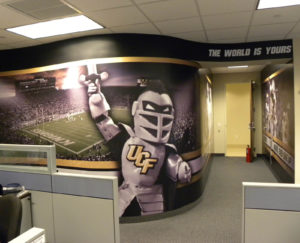
Phillip Glover, vice president of client management for Green Textile, says the primary focus for EnduraFab™ is signage and banners. “However,” he adds, “it might work well for certain applications
of interior décor, such as accent pillows.”
“I think the trend is going away from traditional vinyl to more and more textiles,” Rueb says. “And you’re going to see more backlit fabrics.”
Siegel sees the integration of experiential elements and materials that respond or change based on user preference as an evolving trend.
“Creating smart surfaces that are aesthetically beautiful and functional to enhance communication, provide feedback and create novel experiences is part of this trend,” he says.
“The digital printing industry is at the tipping point where productivity, running costs and the range of substrates and solutions have expanded so much that digital printing economics are more attractive than they were a few years ago,” Lavi says. “Digital is all about printing on demand, delivering what is needed when it’s needed, and reducing costly inventories. We anticipate a fast growth in new segments such as window blinds or upholstery, and rapid prototyping with HP latex technology that speeds up the time from design to manufacturing. New players with go-to-market strategies will appear, as this is a
very exciting business opportunity for many digital printing companies.”
Janice Kleinschmidt is a magazine editor and freelance writer based in San Diego, Calif.
 TEXTILES.ORG
TEXTILES.ORG


